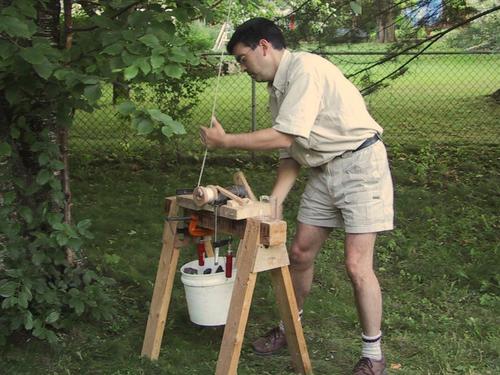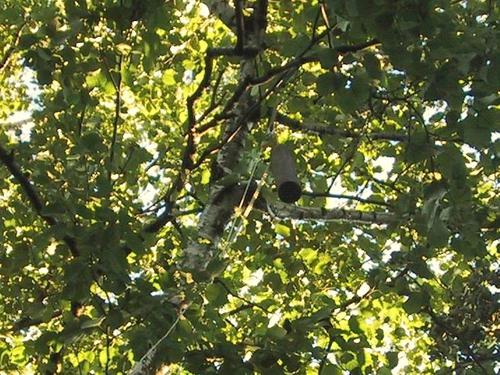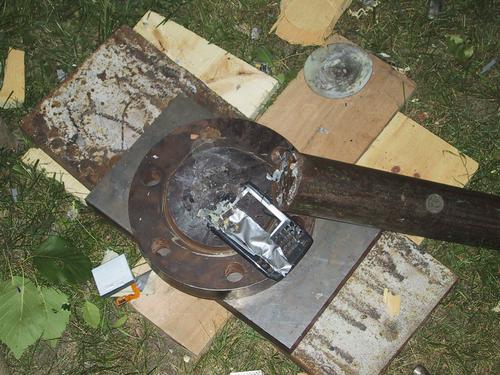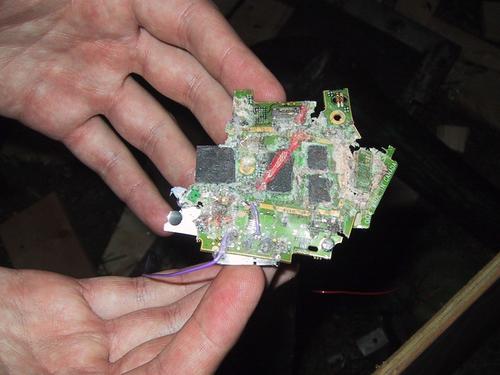Extreme drop testing
For Hardware testing of mobile devices such as the BlackBerry® always involves a test known as a "drop test", where the device is repeatedly dropped onto a hard surface from a specific height to see if this breaks the device.Typical drop tests involve heights of less than one meter. Dropping it from higher is of course more fun, but that requires having something high enough to drop the device from. A more efficient way to apply kinetic energy to the device is to drop a heavy weight onto it, which is what this page is all about.
 Weight fully raised and ready for a drop |
SetupThe nspiration for this whole madness was a steel cylinder (about 7 cm in diameter, 40 cm long, and 12 Kg in weight) that was among the junk left behind in my garage when I bought my first house. I figured it might come in handy some day, so I kept it. After my experiments destroying electronics with an ABS-pipe cannon, I figured the next thing to do was to construct something that would allow me to crush things by dropping this heavy weight on them.
I made a hook with a pulley attached to it to hook onto a high branch in a tree. I attached several long pieces of wood end to end to reach up that far, 8.5 meters above the ground.
I also needed some sort of 'anvil' to drop the weight on. For this, I bought a 1" thick steel plate, which I placed on several small concrete slabs on my lawn. The next step was to invite some co-workers over for a barbecue and electronics crushing event. |
Experiments
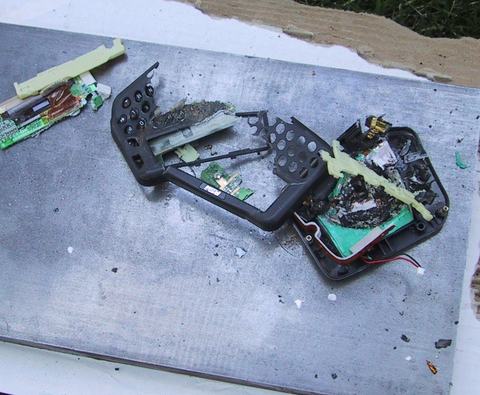
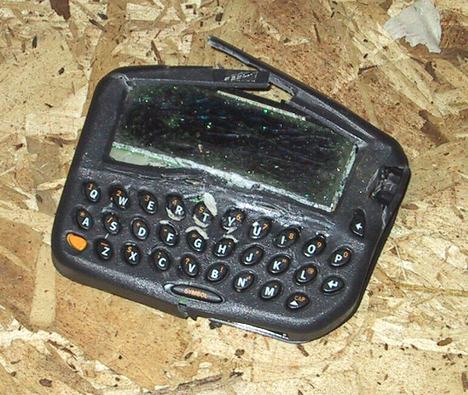
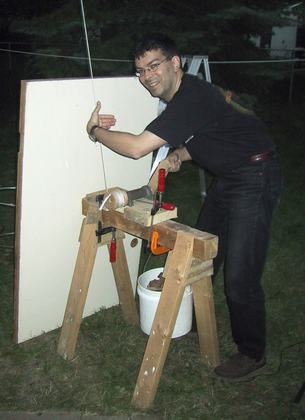
|
A coworker cranking up the weight. The big slab of wood serves as a shield to keep my winch from getting dirty when testing with soft fruit and vegetable targets. |
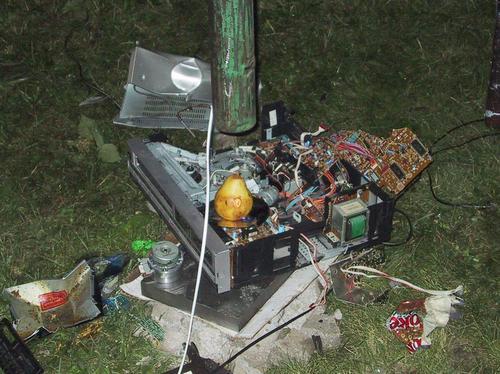 Soft fruit and VCR combo target
Soft fruit and VCR combo target
Unfortunately, the soft vegetable targets didn't give any interesting 'after' results - just a sticky mess everywhere!
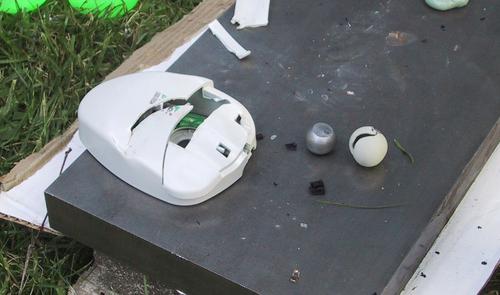 Crushed mouse
Crushed mouse
This mouse survived amazingly intact from a drop. The steel weight inside the
rubber-coated mouse ball, being the hardest thing, ended up absorbing most of the
impact.
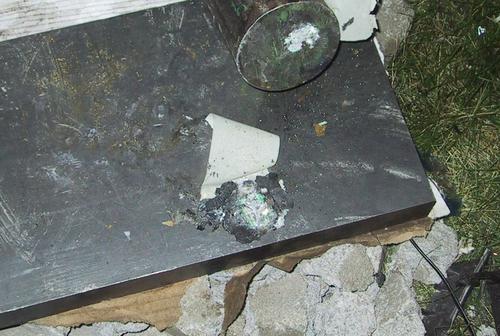 Crushed inexpensive LCD watch
Crushed inexpensive LCD watch
We taped the watch to the bottom of the weight and dropped it with the weight, hence
the piece of masking tape.
The watch was about half the diameter of the crushed mess in the photo before the
drop. Takes a licking, but no longer ticking! I bet a TIMEX wouldn't have done much better!
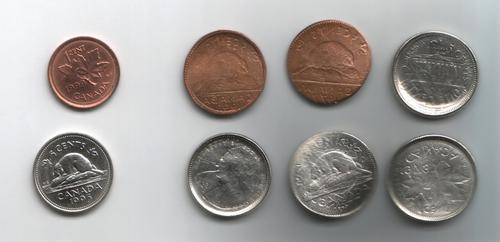 The result of dropping on a stack of coins
The result of dropping on a stack of coins
This was a stack of alternating Canadian pennies and nickels. The pair on the left is
unmodified currency, the ones on the right were in the stack. Notice how the ones on
the right are a little bigger, and how the nickels have the imprint of the penny and vice
versa!
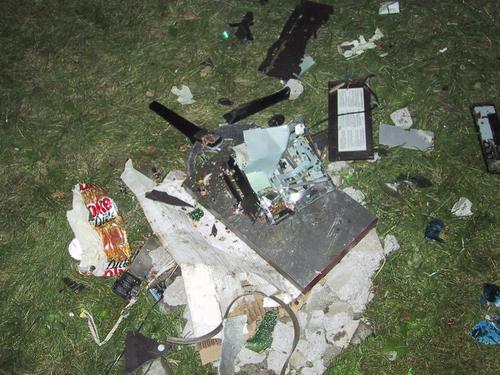 And this is what the test site looked like after a long series of tests!
And this is what the test site looked like after a long series of tests!
The concrete slabs under the steel plate were pulverized, and the whole lawn under
the rubble was indented by about 5 cm. There were crushed bits of electronics and sticky bits
of fruit everywhere. Even after cleaning up, I still find the odd capacitor or other
electronic components in my lawn. But it was worth it!
I organized another such event in 2001, here's some pictures from that one:
(sorry, I ended up removing most of these pictures. In an unrelated video, I used
a picture without asking for permission. I blurred all the faces, but someone's friend
recognized them from the back (face not shown). And with facebook under great suspicion
these days (2019), I figure people are more concerned about online things. The remaining
faces are of people I know well enough.
This one was crushed as bare circuit board. The level of flatness is
really astounding. The red streak across the board was once a wire.
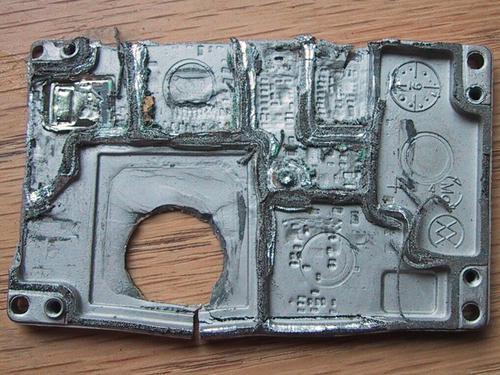 Another fascinating result. The magnesium shield had been pushed onto the
circuit board with such force that all the chips and surface mount components
left imprints in the metal!
Another fascinating result. The magnesium shield had been pushed onto the
circuit board with such force that all the chips and surface mount components
left imprints in the metal!
Six years later, I did some more extreme drop tests
Back to the BlackBerry smashing page
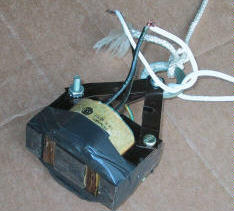 My first idea was to build some sort of track for the weight to slide
down on, so that it could precisely hit its target. But unless
I built something humongous, that would have limited the height I could achieve.
So instead of a track, I devised a precise method of releasing the weight,
so that it would drop exactly on target.
I made an electromagnet out of an old transformer. Interrupting the current
would allow the weight to be released without any jerking motion that
might cause the dropto deviate from exactly vertical.
The force of the weight on the tree caused the tree to flex a little, so I always
had to winch the weight just above the target before checking the aim.
My first idea was to build some sort of track for the weight to slide
down on, so that it could precisely hit its target. But unless
I built something humongous, that would have limited the height I could achieve.
So instead of a track, I devised a precise method of releasing the weight,
so that it would drop exactly on target.
I made an electromagnet out of an old transformer. Interrupting the current
would allow the weight to be released without any jerking motion that
might cause the dropto deviate from exactly vertical.
The force of the weight on the tree caused the tree to flex a little, so I always
had to winch the weight just above the target before checking the aim.
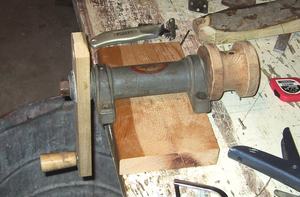 I first tried pulling the weight up just by pulling on the rope
I needed work gloves to avoid injurying my hands with the rope,
but I couldn't get a good enough grip with the gloves. It didn't feel safe or secure.
So I built a winch for cranking up the weight. I used a mandrel
that was meant for a grind stone, replaced the pulley with a big wooden
bobbin, and mounted a crank on the grind stone end.
I attached this to a saw horse, and weighed the saw horse
down with a bucket full of old iron parts to keep it from getting lifted in the air.
I first tried pulling the weight up just by pulling on the rope
I needed work gloves to avoid injurying my hands with the rope,
but I couldn't get a good enough grip with the gloves. It didn't feel safe or secure.
So I built a winch for cranking up the weight. I used a mandrel
that was meant for a grind stone, replaced the pulley with a big wooden
bobbin, and mounted a crank on the grind stone end.
I attached this to a saw horse, and weighed the saw horse
down with a bucket full of old iron parts to keep it from getting lifted in the air.
